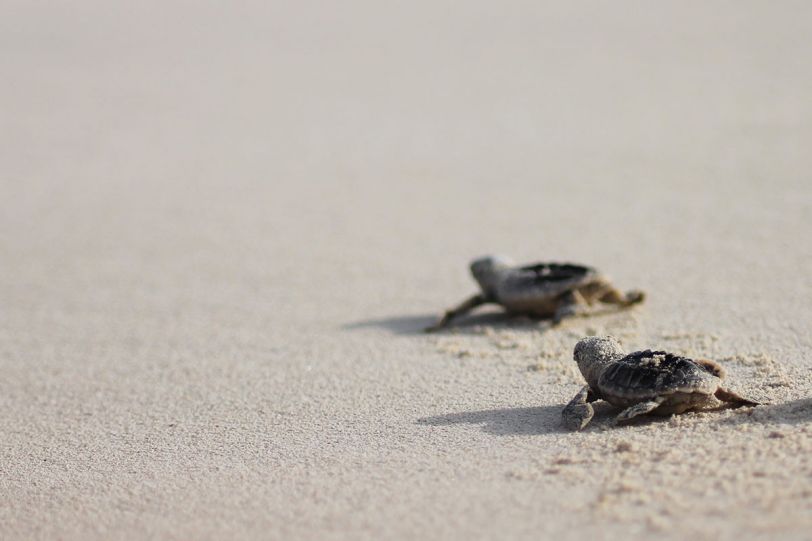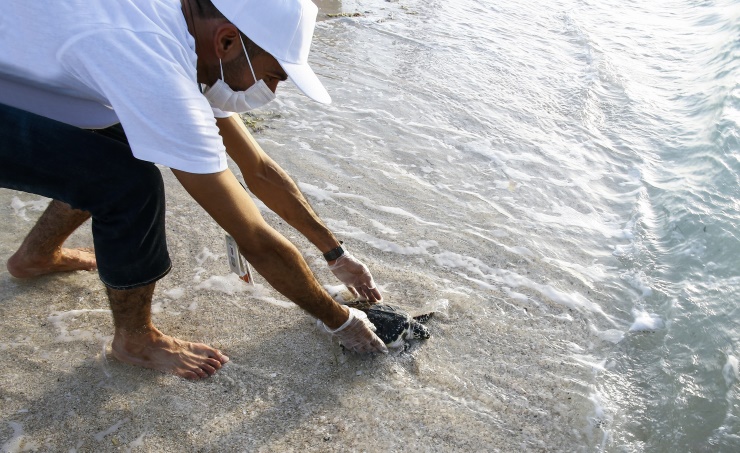Community unites to help the critically endangered hawksbill turtle – the only species in the Gulf that nests in Abu Dhabi.
A group of rehabilitated turtles has been released into Abu Dhabi waters in the Al Dhafra region thanks to a partnership between the Environment Agency – Abu Dhabi (EAD) and Nawah Energy Company, the Joint Venture nuclear operations, and maintenance subsidiary of Emirates Nuclear Energy Corporation (ENEC), BNA reports.
According to a press release issued on Sunday, WAM reports, the partnership reflects the dedication of EAD, ENEC, and Nawah towards the conservation of biodiversity and their commitment to the local environment.
The turtles were initially rescued by Nawah’s team of environmental volunteers, who conduct regular checks of the beaches that surround the Barakah Nuclear Energy Plant. Following their rehabilitation, in partnership with National Aquarium, 17 turtles were released back into their natural marine environment by the teams of EAD and Nawah during a special release gathering, attended by Ali Al Hammadi, CEO of Nawah, and Ahmed Al Hashmi, Acting Executive Director, Terrestrial and Marine Biodiversity Division of EAD.
“There are several energy organizations that have placed environmental activities at the top of their agenda, and Nawah is a prime example of leadership in the conservation space,” Al Hashemi said.

“Throughout our partnership, its team has shown their utmost devotion to the preservation of the environment. This has primarily been reflected in the great lengths they have gone to in rescuing distressed turtles, and joining us in releasing them back into the wild so they can thrive once again.”
Since June 2021, the Environment Agency – Abu Dhabi has taken part in three turtle release programs. The first event involved the release of 150 sea turtles to their habitats after rehabilitation. In the second, a large group of previously rescued turtles was released at Saadiyat Rotana to celebrate World Sea Turtle Day.
The agency plans to release more than 150 turtles, with some tagged with satellites to monitor their behavior, habits, and migration paths.
Abu Dhabi is home to 5,500 marine turtles – both Green Turtles and Hawksbills, and the occasional loggerhead. The Green Turtles and Hawksbills being the two predominant species found in the Emirate’s waters and have been monitored by a longstanding research program founded by the agency in 1998.
Nesting Only in Abu Dhabi
Although both the green turtles and the hawksbill turtles are commonly found in the Arabian Gulf, only the hawksbill turtles nest in Abu Dhabi. Saadiyat Beach, which is only a few kilometers from the NYU Abu Dhabi campus, is one of 17 nesting sites in the Emirate.

Saadiyat Public Beach is part of the long stretch of nesting ground for hawksbill turtles. NYU Abu Dhabi is not far from it.
Efforts to Protect Hawksbill Turtles
Listed as critically endangered by the World Wildlife Fund (WWF), even more attention has been given in the past few years to ensure mother turtles not only make it to shore to lay their eggs but their hatchlings are protected until they are ready to head back to sea again.
New York University Abu Dhabi told the story of Arabella Willing, a marine biologist. She works as the head of conservation and community engagement with Park Hyatt hotel on Saadiyat Beach. Willing used to do turtle patrolling on her own. Still, with a new section of the beach opened up for monitoring this year, she is partnering with volunteers from the NYUAD Community Outreach office to join forces.
The beach patrol now stretches out to seven and a half kilometers one way, making it approximately 15 kilometers on return. “It’s quite a long way for one volunteer to be monitoring,” Willing chuckled. With the help of volunteers, the patrol is divided into three shorter sections, each between three to six kilometers.
Besides the patrol, beachside hotel properties on Saadiyat island also have a few added measures for a more productive environment for the turtles. Lights near the beach are dimmed, noise pollutions are reduced, and sunbeds are not too close to the sea as they may hinder a turtle coming to shore.
Turtle Patrol Volunteer
NYUAD student Killian Dumont is one of the volunteers who signed up for turtle patrol. She learned about the initiative through her Global Climate Change class by Professor David Holland. Willing was a guest speaker during one of the classes and had given a presentation about turtle conservation work in Abu Dhabi.
Dumont, a Colorado native, jumped at the opportunity saying, “After high school, I volunteered at my local zoo (Denver Zoo)… I’m really interested in wildlife conservation and environmental science work.”
While waking up at 5:45 in the morning isn’t the easiest thing to do for most college students, Dumont enjoys her patrol.
There are, of course, the occasional fringe benefits – sightings of dolphins jumping out of the water, and encounters with starfishes and sea snakes that didn’t quite make it out when the high tide retreated.

Hawksbill Turtles Important for the Arabian Gulf
NYUAD Associate Professor of Biology, John Burt, uses the Arabian Gulf to study coral reef ecology in extreme environments. Hawksbill turtles in these waters, he said, are a critical part of the ecosystem.
“While hawksbill turtles are best known for their role in consuming sponges that compete with corals on reefs, populations in (this region) have a more varied diet and can also consume large volumes of algae — a much faster growing and more common competitor to corals on reefs in the Emirates,” Burt said.
A reduction in hawksbill turtles tips the balance of the ecosystem as sponges and algae overgrow and essentially smother the corals. What’s more, algae in large numbers, the known as algae bloom, is potentially harmful to humans.
Globally, hawksbill turtles are experiencing an estimated 80% decline in the past three generations, Burt added.
Where Art Thou Turtles?
April and May are the peak months for nesting. As the beach patrol moves into June, there’s no sign yet of turtle tracks nor their precious eggs that look a bit like ping-pong balls.
While mother turtles don’t come up every year to nest, the modified natural coastal environment around Saadiyat Beach may also be a reason for the no-show so far.
“Coastal modification through the addition of seawalls, breakwaters, ports, and related structures has removed much of the beach-nesting habitat for green and hawksbill turtles in many parts of the Gulf,” Burt commented.
How You Can Help
Join environmentalists in the turtle patrol.
Members of the public or members of the NYUAD community can email nyuad.community.outreach@nyu.edu to join the turtle patrol. Patrolling usually finishes at the end of June.
Look out for turtles
Keep an eye out for turtles’ nests the next time you visit a beach in Abu Dhabi. If you spot a stranded turtle or see a nest, call Tourism Development & Investment Company (TDIC) at 800-8342 for support.
Pick up trash
Picking up trash along the beach ensures that plastic does not end up in the sea and get mistaken as food. Turtles often mistake plastic bags as jellyfish (a food source), and it becomes a choking hazard for them.
Remove nurdles
Nurdles are small pallets made out of plastic and are raw materials used in manufacturing plastic products. Sea creatures often mistake them as food, and once ingested, these toxic pallets get lodged into their body tissue. It becomes a vicious cycle that can impact human lives because we consume them as seafood.You may read about hawksbill turtle nesting monitoring in Qatar here.



